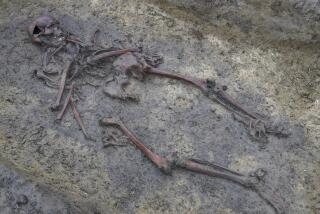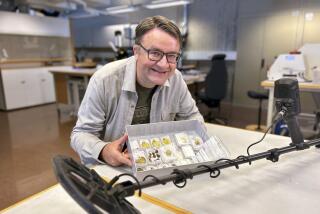Archeologists Unearthing Viking Secrets
- Share via
BIRKA, Sweden — The center of the Viking world 1,000 years ago is under siege by archeologists who are trying to pry secrets from beneath the pastures that now cover this farming island.
Historians believe that Birka, a settlement on an island in Lake Maleren just west of Stockholm, was home to about 1,000 people. The site now is covered with grids, in which workers dig by hand through the seven feet of dirt covering the settlement.
Two sections have been excavated since the dig began this spring and although the findings have not been startling, they hint at a wealth of artifacts to come. The project is to last until 1994.
Animal bones, remnants of meals, colorful beads, combs and household utensils that could shed light on Viking home life have turned up. Archeologists also found Arab coins, evidence of how far the Vikings roamed.
The Vikings thrived from the late 8th Century to the 11th Century. Their raids struck terror throughout Europe, and their spirit of adventure drove them far afield, to Iceland and North America.
Birka has been recognized since the Middle Ages as the cradle of Christianity in Sweden. It was here that Ansgar, a missionary from Bremen and later bishop of Bremen-Hamburg, first preached around 830.
But while some Viking towns flourished, Birka was deserted at the end of the first millennium. Where traders once exchanged goods from all of the known world, sheep graze in meadows and on grassy mounds containing the graves of Viking traders.
Historians say Vikings from the Birka region, a people known then as Rus, sailed eastward across the Baltic Sea and lent their name to the land of Russia. They reached the Caspian Sea.
Although Birka was the Vikings’ center, it has remained mostly unexamined while extensive digs were conducted at Viking settlements in York, England; Dublin, Ireland; Hedeby, West Germany; Kaupang, Norway; and Staraya Ladoga, Soviet Union.
The Viking era generally is regarded as having begun in 792, the year a raiding party attacked the Lindisfarne monastery on Britain’s North Sea Coast. But evidence could be uncovered indicating that the era began earlier, said Bjorn Ambrosiani of Stockholm’s Museum of National History.
The only previous excavation of Birka was conducted 100 years ago by Hjalmar Stolpe, a zoologist who came in search of insect fossils in 1871 and stayed 24 years to dig up many of the 2,500 Viking-age graves.
Stolpe touched very little of the town of Birka, which stood at the focus of a heroic chapter in Scandinavian history. Ambrosiani and other experts are eager to find out how it was built and developed.
The project is being financed by one of Sweden’s richest men, industrialist Gad Rausing.
“If you go digging you should have proper resources, otherwise you do more damage than good,” Ambrosiani said.
Rausing, who has a doctorate in archeology, said he persuaded the board of directors of his family’s Tetra-Pak packaging company to donate $2.4 million to the project for high-tech assistance--computers to register the findings daily, and video equipment to document the objects.
More to Read
Sign up for Essential California
The most important California stories and recommendations in your inbox every morning.
You may occasionally receive promotional content from the Los Angeles Times.










